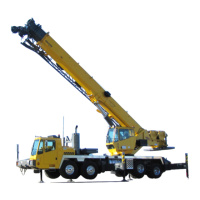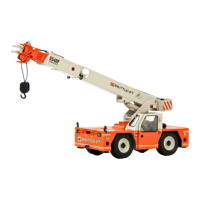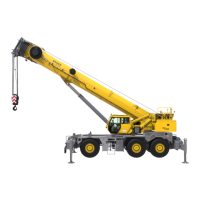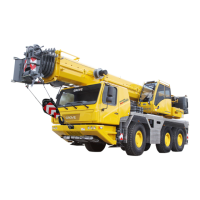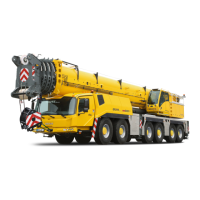OPERATING PROCEDURES TMS9000-2 OPERATOR MANUAL
4-32
Published 02-21-2019, Control # 611-05
Differential Control Switches
There are two differential switches for controlling the tandem
axle differentials, the Inter-Axle Control Switch and the
Cross-Axle Control Switch.
The Inter-Axle Control Switch is used to control the locking
capability between the front and rear axles in the tandem set.
The switch has two positions, LOCK and UNLOCK.
The Cross-Axle Control Switch is used to control the locking
capability between the right and left wheels in the tandem
set. The switch has two positions, LOCK and UNLOCK.
Operation of the vehicle with differentials locked increases
wear on tires, axles, drive shafts, and the transmission.
These features should only be utilized as required for
mobility.
Operating the Differential Locks
The Inter-Axle and Cross-Axle differential locks should
preferably be engaged when the crane is STATIONARY but
may be engaged when moving if the following conditions are
met.
1. The crane is moving very slowly (creep speed).
2. The wheels are not spinning at the time of engagement.
When traveling with the lock(s) engaged do not deviate from
a straight path more than is absolutely necessary.
1. When operating the differential lock(s), position the
appropriate switch to the LOCKED position with the
crane stationary or at slow speed.
2. If moving at slow speed, let up momentarily on the
accelerator. This will engage the differential lock(s).
3. Proceed over the poor road condition cautiously.
When the adverse condition has passed, adhere to the
following:
1. Position the appropriate differential lock(s) switch to the
UNLOCKED position while maintaining slow speed.
2. Let up momentarily on the accelerator to allow the shift.
3. Resume driving at a safe speed.
Brakes
NOTE: If the pressure drops below 14 kPa/0.14 bar (2 psi)
per minute with the engine stopped, have the air
system checked for leaks.
This Grove crane is equipped with an anti-lock braking
system (ABS) which controls the braking for all four axles.
For most effective braking and for maximum life from brake
system components, the following suggestions are made.
• Air brakes have light pedal operation and the driver is
cautioned to use extreme care in application until a good
feel is achieved.
• With ABS, push the brake pedal while steering normally
and keep your foot firmly on the brake pedal until the
crane comes to a complete stop. Don't take your foot off
the brake pedal or pump the brakes, because that will
disengage the anti-lock system. It is normal to feel a
pulsing sensation from the brake pedal with ABS brakes.
• Remember that you can steer while you are braking with
anti-lock brake systems. Steer clear of hazards while
keeping your foot firmly on the brake pedal. Be aware
that your vehicle will not turn as quickly on a slippery
road as it would on dry pavement.
• Use the engine as a brake when approaching a stop or
when going down a long grade. On a downgrade, use
the same transmission gear as would be needed to go
up the same grade.
CAUTION
Do not engage the Inter-Axle Control Switch or Cross-
Axle Control Switch while the wheels are actually slipping
or spinning. This will result in damage to the drive train
components.
CAUTION
Avoid Crane Damage!
Do not engage the parking brake while the vehicle is
moving. Damage to the crane can occur.
Disengage the parking brake before driving. Damage to
the crane can occur.
WARNING
If low pressure occurs and the buzzer sounds during
operation, stop immediately and determine the cause of
air loss. Downshift, use the engine as a brake, and make
the final stop using a single brake pedal movement to
avoid excessive loss of air and consequent sudden
engagement of the automatic spring brakes.
Ensure the brakes are released before making any
attempt to drive or drive train damage will result. The
parking brake is to be used for parking only. Do not use
the parking brake for stopping the crane except in case of
an emergency, as a severe sudden stop will occur.

